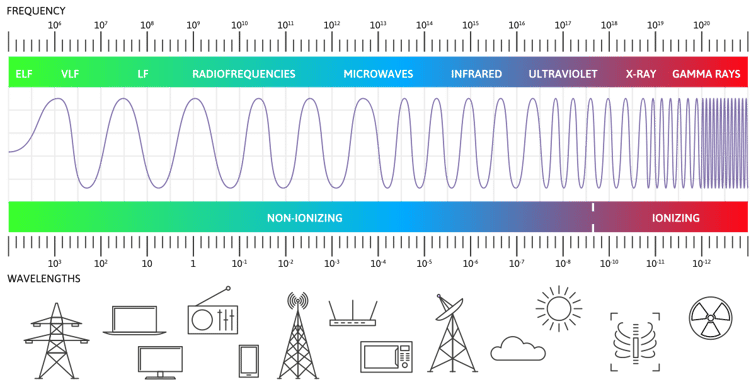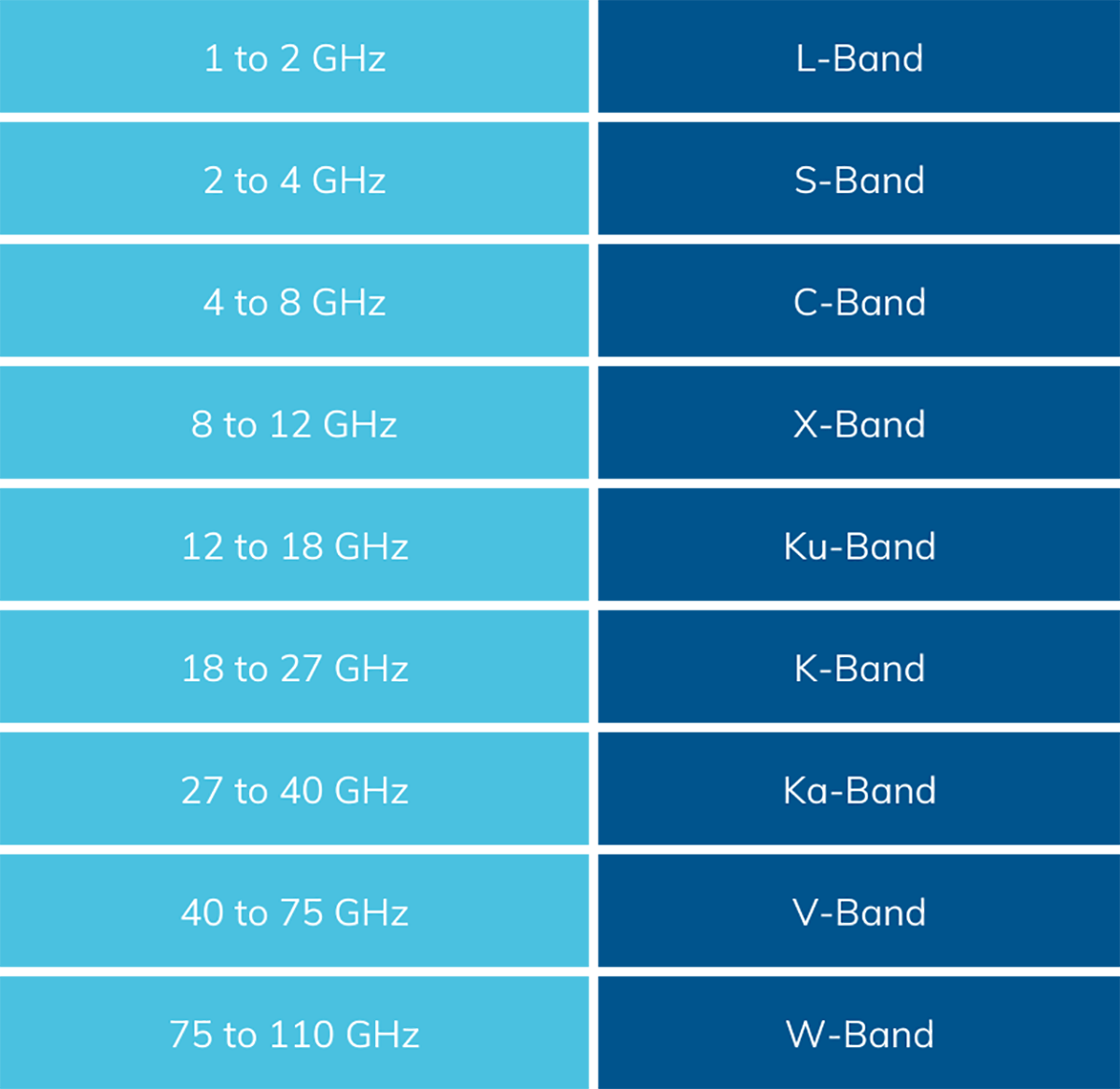Electromagnetic waves comprise electric and magnetic fields. A radio “frequency” is an electromagnetic wave that uses alternating current (AC). We use the term “frequency” because we measure how frequently the wave repeats itself each second. These waves, therefore, are defined as frequent, consistent, and repetitive. Hertz (Hz) is the standard measure of frequency or the number of cycles per second. The electromagnetic spectrum is a collective term to refer to the entire range and scope of frequencies of electromagnetic radiation from 3 Hz to 300 Exahertz (EHz) which is equal to: 300,000,000,000,000,000,000 Hz!
The Electromagnetic spectrum
A spectrum helps to classify concrete objects or abstract ideas on a scale between two end points. Think of the “political spectrum”, for example, or the “socio-economic spectrum.”
A “radio spectrum”, then, is part of the electromagnetic spectrum. Check out the cool chart below:

Effective frequency manipulation, control, and coverage are essential to RF/microwave systems especially as greater portions of the electromagnetic (EM) frequency spectrum are used for an ever-growing list of applications. To properly reach their destinations intact, EM signals must stay within designated channels, generating as little interference as possible on other signals outside their frequency bands.
There is an alphabet in those frequency bands!
The EM frequency spectrum is broad and includes many types of waveforms, starting with audio and extending through to radio frequency (RF) waves, microwaves (3 to 30 GHz), millimeter waves (30 to 300 GHz), infrared (IR), visible light, and ultraviolet (UV) waves. Each portion of the spectrum must be treated very differently in terms of electrical and mechanical design and manufacturing since the length of the waves shrinks with increasing frequency.
Even within one portion of the spectrum—such as the microwave or millimeter-wave frequency ranges—components must be designed and built specifically for the signal frequencies being handled. In the RF, microwave, and millimeter-wave ranges, letters have been assigned over the years to help define the frequency bands, as designated by several technical organizations such as the Federal Communications Commission (FCC), the Institute of Electrical and Electronics Engineers (IEEE), and the National Aeronautics and Space Administration.
The frequency band letter designations in use today do not follow any kind of logical sequence—for example, A to Z for ascending frequencies—but have instead been assigned for assorted reasons over the years. According to the IEEE, the frequency band letter designations for the range from DC to 110 GHz are:
FREQUENCY BAND LETTER DESIGNATION FOR BENCHMARK'S FREQUENCY RANGE OF "DC" TO 110 GHZ:

The frequencies represented by each letter band accommodate a variety of applications from short-range, point-to-point communications to advanced electronic-warfare (EW) and radar systems. The first frequency band letter—L—was assigned by the IEEE to designate the long-wavelength (or low-frequency) end of the microwave frequency range (1 – 2 GHz) where the signal wavelengths—the distance between two crests of electromagnetic waves—extend from 30 to 15 cm.
l-Bands and s-bands, oh my!
Some of the best-known applications within the L-band frequency range are for satellite navigation from orbiting satellites in the Global Positioning System (GPS) and the Russian GLOSNASS systems for both military and civilian users. GPS satellites send signals centered at 1575.42 MHz and GLOSNASS satellites at 1602 MHz to enable receivers to determine their precise positions on the Earth below. Those frequencies were selected for their low attenuation when traveling through clouds, rain, and other weather-related interference.
The S-band frequencies (2 – 4 GHz) cross the boundary between the extra-high-frequency (EHF) and super-high-frequency (SHF) ranges and were given the “S” designation by the IEEE. The best-known application within the S-band range is probably the microwave oven although most of us are unaware that the source of heat is a 2.45 GHz magnetron tube producing non-ionizing EM energy to vibrate the food molecules. Many users of wireless local area networks (WLANs) based on IEEE 802.11b and 802.11g networking standards are also probably unaware (or unconcerned) that their network equipment is wirelessly connected by means of signals within the S-band frequency range.
C, X, Ku, Ka, V, and W Bands, Oh My!
Frequencies within the next frequency band—from 4 to 8 GHz—are well suited for long-range communications. Therefore, the IEEE designated this as C-band for communications. The FCC, however, felt that the full 4 to 8-GHz range was not ideal for communications and separately defined the C-band frequency range as 3.7 to 4.2 GHz (although only in the United States is that narrower portion of the band considered as C-band frequencies).
The FCC felt C-band frequencies should include only 3.7 to 4.2 GHz because of their excellent propagation characteristics and low atmospheric attenuation. They also felt that the C-band range should play a significant role in 5G wireless communications networks. The C-band range is also used for weather radar, satellite communications (satcom), Wi-Fi wireless networking systems, and radar altimeters for aircraft.
The IEEE considers the frequency range from 8 to 12 GHz as X-band and it is often used for applications above the atmosphere, including radar, fixed and mobile satcom, and deep space exploration. Frequencies above that range—from 12 to 40 GHz—were originally designated as K-band by the IEEE. However, the heavy rainfall/water-vapor attenuation at 22.23 GHz prompted a reconsideration of the single band into three “K” bands. Frequencies below that attenuation peak—from 12 to 18 GHz—are considered Ku-band for the “K-under” frequencies. Frequencies above the attenuation peak—from 26.5 to 40.0 GHz—are known as Ka-band frequencies for the “K-above” frequencies. The remaining bandwidth—from 18 to 27 GHz—is considered K-band. Frequencies from 40 to 110 GHz are encompassed by the V- and W-band designations with many additional letters appointed to frequency bands higher than 110 GHz.
Let Benchmark Help You Add a Letter or Two to Your Frequency Band Alphabet!
As humanity expands its use of the EM spectrum, higher frequencies become of greater interest for military, industrial, and even commercial applications such as Sixth Generation (6G) wireless communications networks. The alphabet will continue to identify which frequency bands fit which applications.
From band to band, engineering and manufacturing challenges vary widely. Optimal material selection, potential causes-and solutions for-interference, and efficient use of signal power can be very different from band to band. That is why you want a product realization solutions partner with experience and expertise across the EM spectrum. Whether you need design and manufacturing help in the Ka/Ku-band, assistance with test strategies in the X-band, or a custom RF filter up to V-band, Benchmark is the partner of choice for RF/microwave and millimeter wave applications.
Want to learn more how Benchmark can support your RF/microwave product? Reach out to Benchmark today. Together, let's add a letter or two to your frequency band alphabet!
